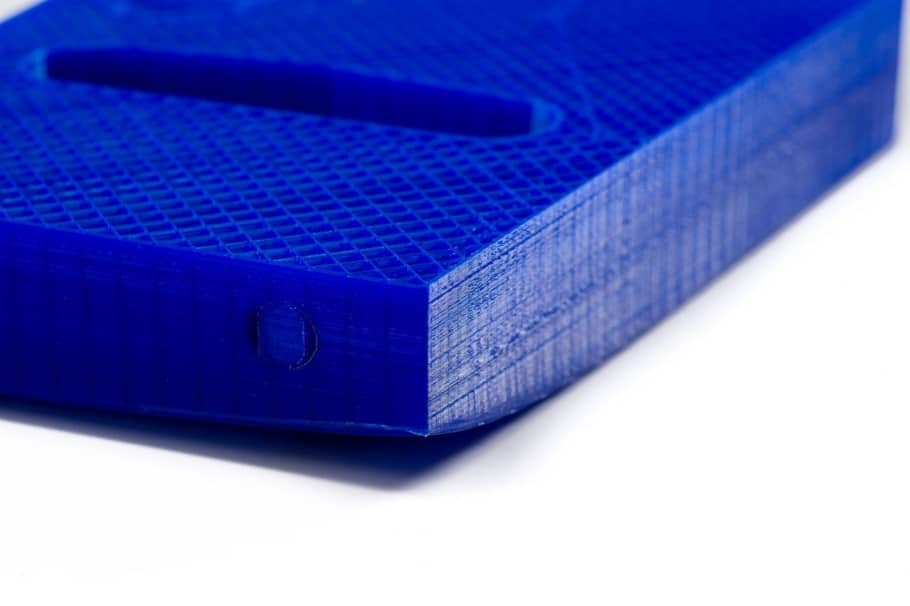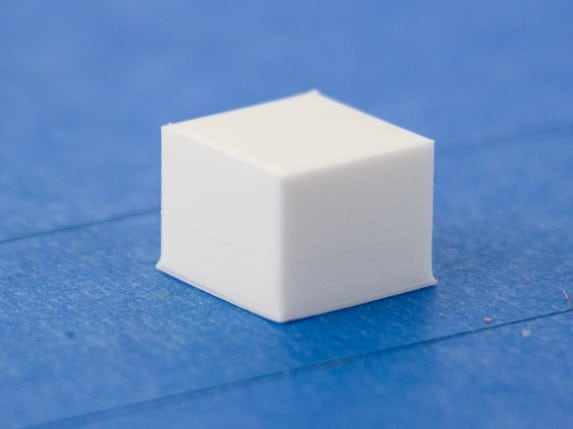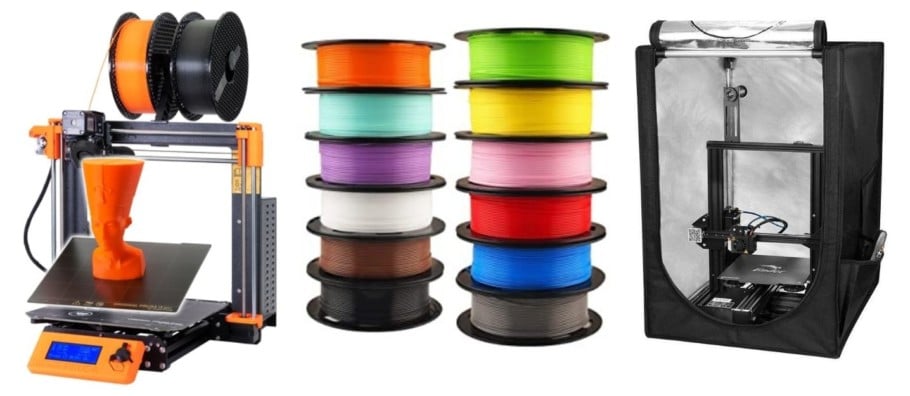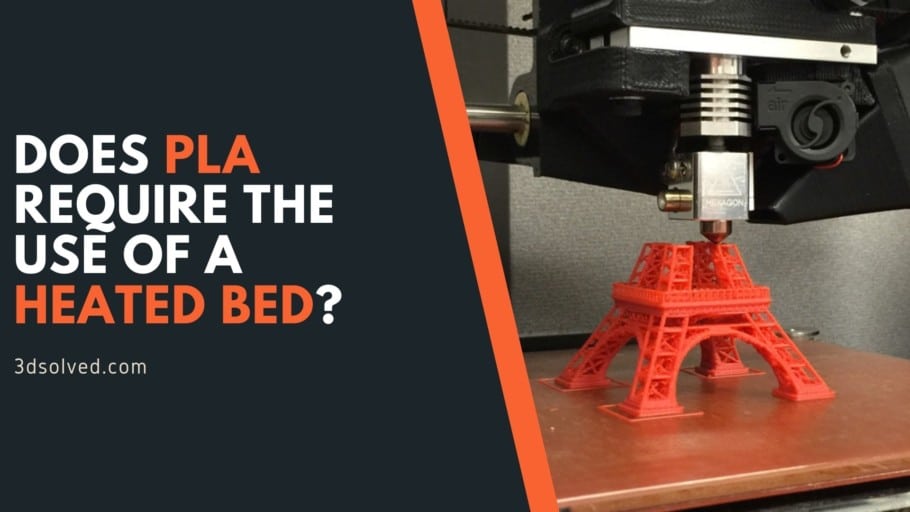You just got started with 3D printing and you bought some PLA, as it’s the easiest filament to print with. Then you realize that the printing bed of your 3D printer can be heated and you think to yourself “huh, should I use a heated bed with PLA or not?”.
So, this is what I will answer today, but it’s not a strictly “yes” or “no” answer because it will depend on a couple factors.
So, without any further ado, let’s get started.
Does PLA need a heated bed?
PLA is printed at a reasonably low temperature, which means that the risk of warping is low. While you can print without a heated bed in most cases, increasing the bed temperature results in a better first layer adhesion, and this translates to a better print quality and less warping overall.
One of the main reasons for using a heated bed is to deal with a bad first layer adhesion which can lead to prints completely detaching from the build surface, as well as warping, which more commonly happens when printing with ABS and not so much with PLA, but a heated bed can reduce the chances of warping even further.
What is warping?
Warping occurs because the temperature differences between the layers of extruded plastic is too big, which in turn, creates tension within the model, and when it gets to be too much, the lower layers start to drag or lift. As a consequence, the model’s corners bend upwards, which is commonly referred to as warping.
However, warping isn’t as much of a problem with PLA as it is with ABS, but it still increases the overall print consistency and aids with bed adhesion.
While PLA can be printed without a heated bed, it improves bed adhesion and keeps the object from moving around and ruining the print.
Heated beds keep prints from warping by keeping the plastic warm during the printing process, maintaining the material close to its glass transition temperature or slightly below it (even though you will get the strongest bed adhesion by going slightly above it, but more on that in a second) which in the case of PLA is 60-65°C, so heating the bed to about 55-60°C should get you great results.
Doing this will give you the best chances of success. However, like I mentioned earlier, PLA can also be printed without a heated bed, and in most cases, without issues.
Advantages of using a heated bed

There are numerous advantages to using a heated bed while 3D printing, especially with materials such as ABS, and even though it’s not strictly required when printing with PLA, there are some definite advantages to using a heated bed, so here they are:
It improves first layer adhesion to the build plate
According to this scientific study which measured the differences in bed adhesion with a heated- and non-heated bed, with PLA printed on both bed materials (Glass and PI sheet) up to a bed temperature of 60°C, a steady rise in the adhesion force is observed, which can be attributed to an enhanced chain mobility of the deposited filament with higher temperatures.
One interesting fact is that the adhesion increased even more when going from 60°C to 70°C. However, 70°C seems to be the limit since going over that temperature will rapidly lower the bed adhesion by about 50% to 60%.
Also, the adhesion behavior of ABS printed onto the glass or PI film exhibits a similar trend to that of PLA. The adhesion forces increase with rising temperature in a non-linear fashion with a maximum slightly above the Glass Transition Temperature (slightly above 105 °C).
Essentially, a heated bed will improve bed adhesion, and if you want to have the print stick as well as possible, heat the bed just slightly above the glass transition temperature.
It helps to avoid warping
Like I mentioned earlier, warping happens because the temperature differences between layers of extruded plastic are too big, which, in turn, creates tension within the model, and when it gets to be too much, the lower layers start to drag or lift. As a consequence, the model’s corners bend upwards.
Heating up the bed means that the deposited material won’t be able to cool off, at least not the first layers, which as we just saw will increase adhesion drastically, but also since plastic shrinks as it cools off, that shrinkage will create tension as the printing process moves forward and may end up warping (curling and separating from the bed).
Essentially, a heated bed will not only help with bed adhesion, but it will prevent that material shrinkage from happening, which in turn will eliminate, or at least lower, the risk of warping.
It’s worth noting that this tends to happen mainly with materials that require extremely high heat to print, such as ABS, and this isn’t that big of a deal with PLA, generally.
But if your PLA prints are coming off the bed or suffer from warping, consider heating up the bed.
How to solve warping issues?
There are a couple ways of dealing with warping, one of which I already mentioned earlier;
- Level your Print bed and adjust the nozzle height: The first layer is the most important one of all and will determine the quality of the print moving forward. Proper leveling of the bed and nozzle height will ensure a good first layer adhesion.
- Increase bed temperature: Like I just mentioned, heating up the bed to the glass transition temperature of the filament you’re using will drastically improve adhesion.
- Use External products to improve adhesion: Glue Sticks, Hairsprays, Kapton Tape, PEI Sheets, Masking Tape, etc. can all help improve layer adhesion. More on this in a bit.
- Print using a Brim or a Raft: Brims are used to hold down the edges of your part, which can prevent warping and help with bed adhesion. Rafts (mostly used with ABS) help with warping and bed adhesion, as well as stabilizing models with small footprints.
Disadvantages of using a heated bed

Image Source: Matterhackers.
Printing with a heated bed should be trouble-free if the temperature is set to the recommended range of 50 to 60°C for PLA, or like mentioned in the Study I linked earlier, if you want the best adhesion possible, then set the bed temperature to 70°C.
However, this isn’t as simple as it seems, since increasing the bed temperature too much can cause another issue commonly known as “elephant’s foot”, which is a visible bulging of the first layer.
Elephant’s foot can happen for a couple reasons, such as setting the bed temperature too high, printing without a raft, of when printing large objects, since the weight of the print will push down on that first layer and make it “bulge” outwards.
What are the Solutions to Elephant’s Foot?
- Level your Print bed and adjust the nozzle height: This is the first- and most important step of all since the first layer may get squished against the bed because the nozzle is too close to it.
- Lower the Bed Temperature: The higher the bed temperature, the higher the chances of elephant’s foot happening. Lower the bed temp by 5°C at a time and check how the print turns out. If you lower the temp too much and the issue still persists, the cause may be another one.
- Print with a raft: Printing a raft means that the raft will be the one suffering from the issue, but this will keep your 3D model intact.
- Alter your model: Alter the model by putting a small 45° chamfer on the bottom of the print, which will compensate for the bulging.
Perfect heated bed temperature for PLA
PLA generally doesn’t need to be printed using a heated bed, but if you can’t get it to properly stick to the bed or if it tends to warp, then try setting the bed temperature as close as possible to the glass transition temperature of PLA (60 °C ).
Essentially, you’re going to want to heat the bed up to around 60°C or lower, since you want to increase adhesion without risking elephant’s foot.
If, for some reason, the print isn’t sticking or is warping, you can try upping the bed temps closer to 70°C, which is the temperature at which PLA sticks the best to the bed (according to the study I linked).
What is the glass transition temperature?
In chemistry, glass transition temperature (Tg) is the temperature at which a material undergoes a transition from a rigid, crystalline state into a glassy amorphous state. In other words, it’s the temperature at which a solid changes its physical properties from hard to rubbery, or malleable, without being melted.
The Glass transition temperature of PLA is 60-65°C, which means that when it reaches those temperatures it will go from a solid state to a more “rubbery” state.
It’s worth noting that Glass transition temperature and melting temperature are two completely different things, since the melting temperature is when the plastic goes from solid to liquid, while glass transition temp is when the plastic becomes rubbery and malleable.
How to further increase bed adhesion with PLA
Assuming you already tried heating the bed, using a Raft and a Brim to further increase bed adhesion and prevent warping but nothing seems to have worked, you can resort to other materials that should help.
- Glue stick: Glue Stick is extremely easy to use; Simple apply it to the print surface and that’s it! You’re ready to print!
- Hairspray: Hairspray tends to stick better to an already heated bed, so before applying it make sure to heat the bed first and then simply spray it on top of the build surface.
- PEI Sheets: PEI is laminated and can be easily placed on any printing surface, and the great thing is that it’s easy to find and it’s also super affordable. Some of them include double-sided stickers, which makes the installation fairly quick by simply adhering it to the build surface.
- Kapton Tape: Kapton tape withstands extremely high temperatures and is often used in electronics to protect components when welding or stripping parts, which makes it ideal for 3D printing since it won’t get damaged when heating up the bed.
- Masking Tape: Masking tape can also work really well, but you will need to be careful when installing it since you don’t want there to be any irregularities between the strips of tape nor any uncovered spaces, otherwise the print won’t stick that well.
Conclusion
I think I made it clear that you don’t need a heated bed when printing with PLA, but the benefits are there.
Try it out for yourself, print without heating up the bed and see how well the object sticks to the bed. Next heat up the bed as close as possible to the glass transition temperature of the filament, in the case of PLA it’s 60-65°C, and see if there’s any noticeable difference.
I hope this information was useful!
Have a great day!
Check out our recommended products section

We created a recommended products section that will allow you to remove the guesswork and reduce the time spent researching what printer, filament, or upgrades to get, since we know that this can be a very daunting task and which generally leads to a lot of confusion.
We have selected just a handful of 3D printers that we consider to be good for beginners as well as intermediates, and even experts, making the decision easier, and the filaments, as well as the upgrades listed, were all tested by us and carefully selected, so you know that whichever one you choose will work as intended.
Error processing API data.
